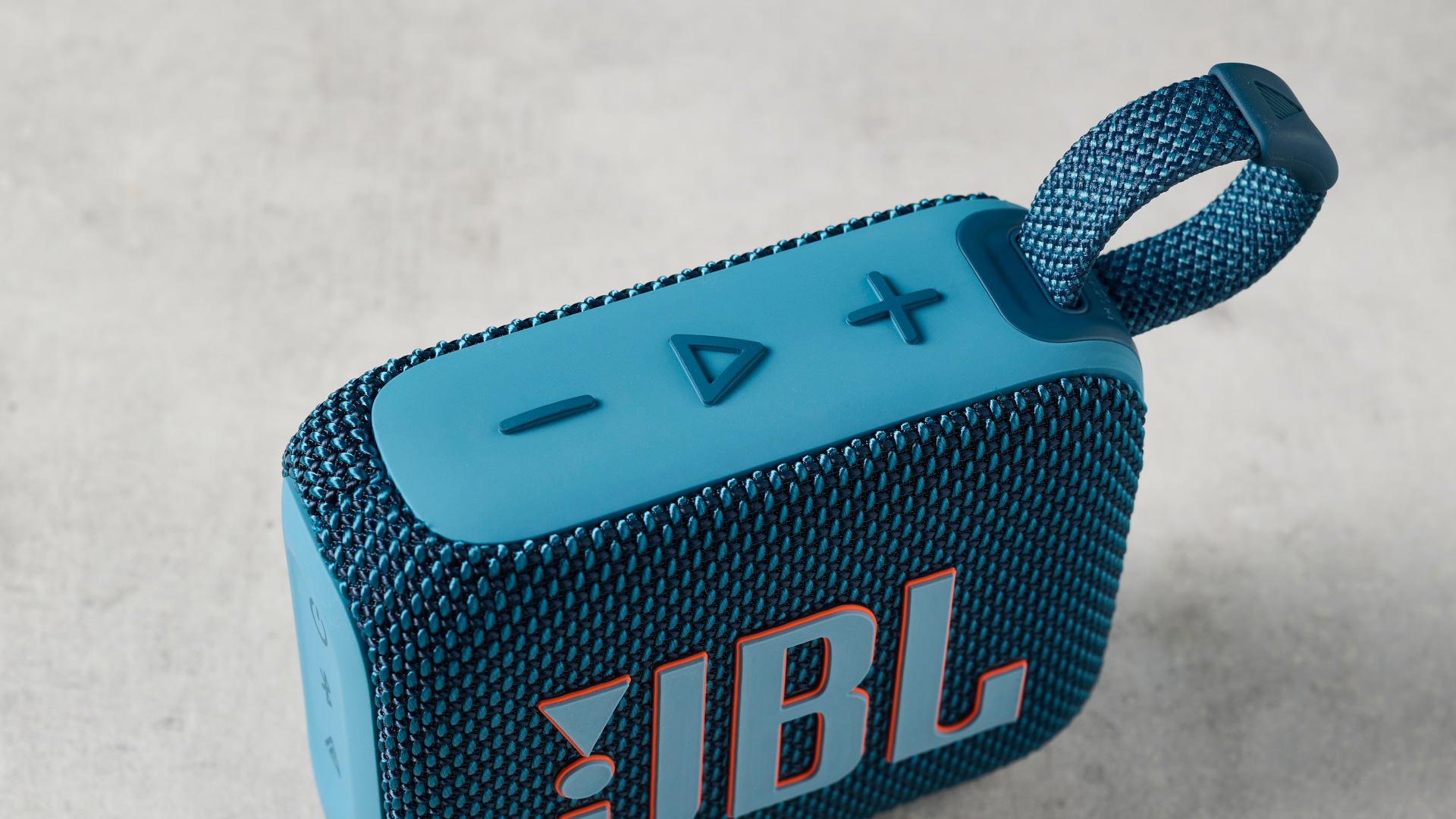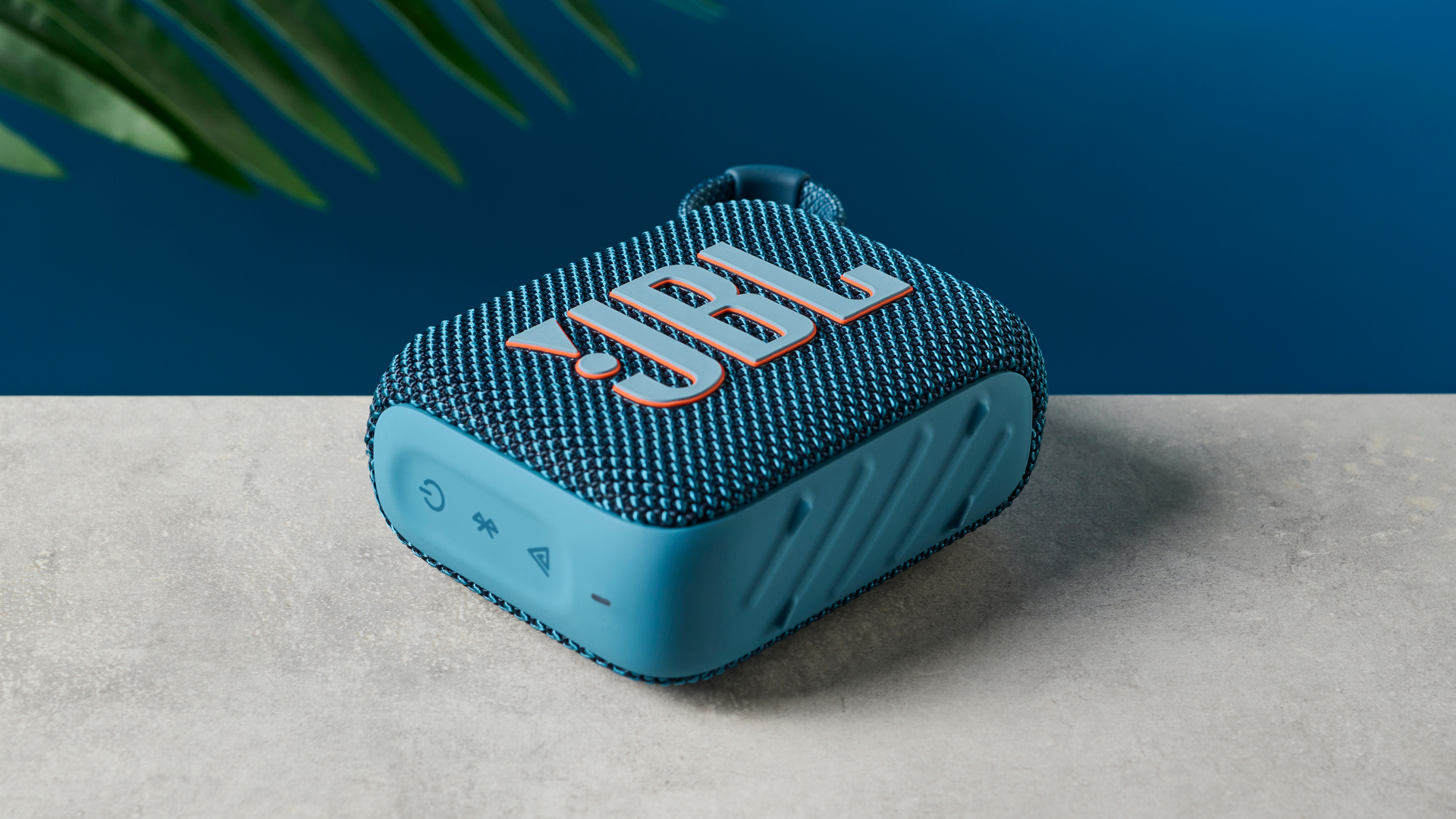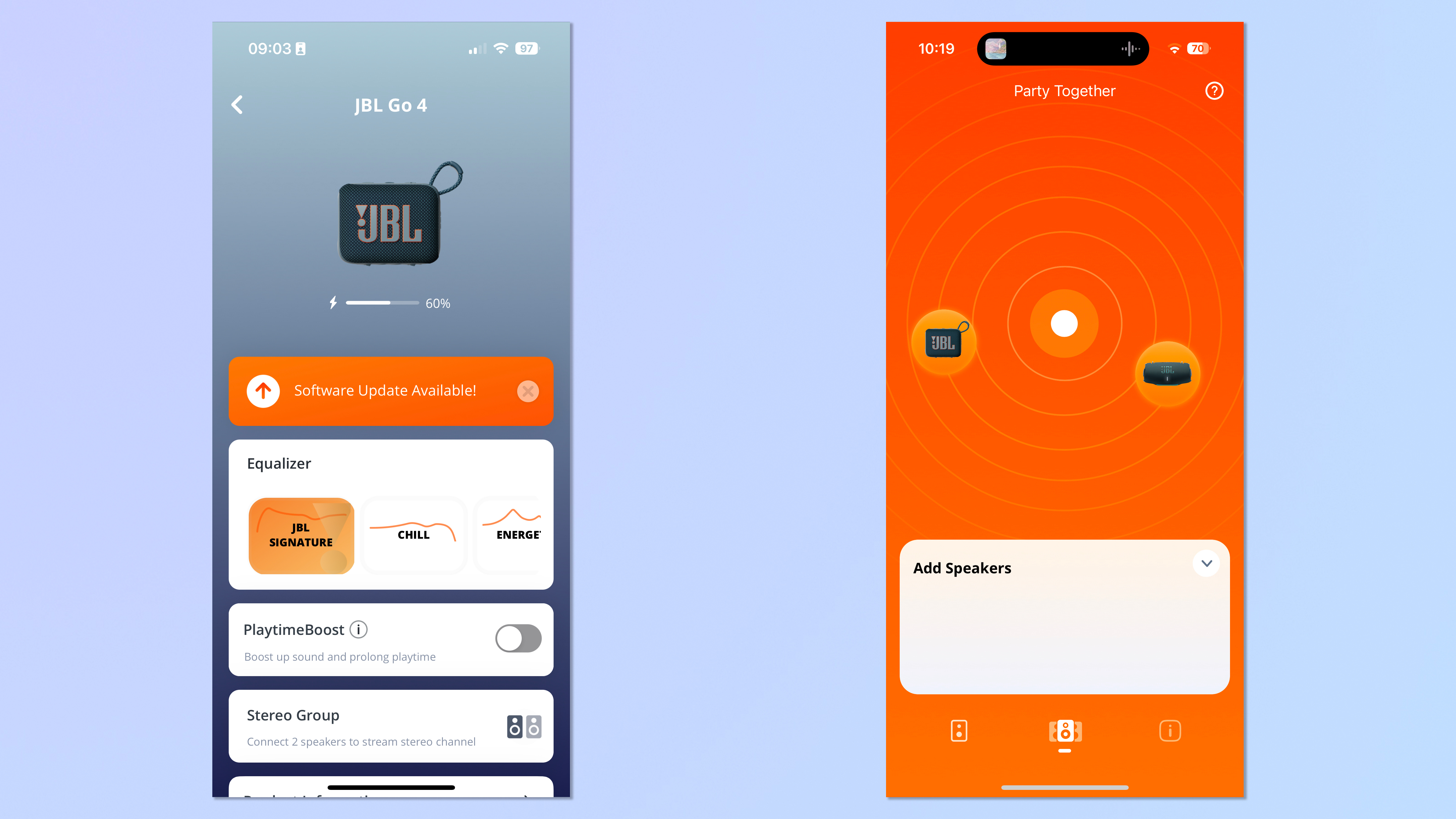Tom's Guide Verdict
The JBL Go 4 is a decent portable Bluetooth speaker for those on a budget. Small enough to take traveling, it still packs enough performance to soundtrack small gatherings while bringing useful features like IP67 water and dust protection, and multi-point connectivity.
Pros
- +
Very portable
- +
Decent sound quality
- +
Strong water and dust protection
- +
Multi-point connectivity
Cons
- -
Not great for sub-bass
- -
Lacks features found on similarly priced rivals
Why you can trust Tom's Guide
Price: $49 / £39
Colors: Black; white; red, blue, pink, purple, camouflage
Size: 3.7 x 3 x 1.7 inches
Weight: 6.7 ounces
Battery life: 7 hours
Connectivity: Bluetooth 5.3
Waterproofing: IP67
The JBL Go 4 is, as you might be able to tell, the fourth iteration of JBL’s Go lineup of compact Bluetooth speakers. While not quite as portable as the ultra-compact JBL Clip series, the Go 4 is nevertheless designed to accompany you on your travels or gatherings with friends with very little fuss.
At just under $50, the JBL Go 4 won’t break the bank, but its pricing puts it into competition with two of the best Bluetooth speakers around — the Tribit Stormbox Micro and Anker Soundcore 3, which both offer features the Go 4 does not.
That said, after testing the Go 4 for a week or two, I think this little speaker has a couple of aces up its sleeve, which might make it a good purchase for you. Read on for our full JBL Go 4 review.
JBL Go 4 review: Price & availability
The JBL Go 4 is available from JBL direct or from Amazon, and costs $49 / £39, making it relatively affordable. This is a similar price to the Tribit Stormbox Micro, our favorite Bluetooth speaker for traveling.
The Go 4 is available in seven different colors, from relatively pedestrian black or white, through to vibrant red, blue, pink or purple, and then onto utterly garish camouflage. You can be as conspicuous as you like.
JBL Go 4 review: Design & controls

The JBL Go 4 looks fairly attractive, with a boxy design featuring a mesh speaker cover over the front and rear faces, with edges wrapped in grippy rubber. Along the rear face are two rubber strips for gripping when laid down, while the base edge also features textured rubber to allow the speaker to stand upright. Overall, while it doesn’t have the premium feel of portable speakers from higher-end manufacturers — the Sonos Roam, for instance — the Go 4 still feels sturdy and well-constructed.
The Go 4 measures 3.7 x 3 x 1.7 inches and 6.7 ounces, so it’s easy enough to slip into a bag or a large pocket without weighing either down too much. It’s a similar size to the Tribit Stormbox Micro, although the Go 4 is slightly smaller and lighter so may be preferable if space or weight are at a premium in your travel bag.
Along the top are controls for volume and playback, decided by number of presses, while the side hosts buttons for power, Bluetooth and speaker hookup — all of these provide firm clicks when pressed and feel decent quality.
JBL Go 4 review: Features
The JBL Go 4 isn’t exactly feature-packed, although for $49 that’s understandable, and besides, it only really needs to do one thing: soundtrack your gathering. Still, it’s nice to see JBL has incorporated some useful features to keep the party going.

The Go 4 is IP67 rated, making it waterproof down to a depth of around 3 feet, so you can drop it into an ice bucket or the shallow end of a pool or pond without destroying it. This is the same waterproof rating as our favorite fully waterproofed speaker, the JBL Charge 5, although that speaker is more expensive than the Go 4 and subsequently brings more premium features.
The Go 4 is also made partly from recycled plastic, which is better than no recycled material, and features Auracast connectivity to link multiple speakers together, which I’ll come onto in the next section. Again, this is a no-frills speaker, but is priced as one.
While the Go 4 has a hook for clipping to a carabiner or attaching to a strap, the Tribit Stormbox Micro has a super useful hook which can be used to mount the speaker to handlebars, so if you regularly travel on a bicycle, that could be a consideration.
JBL Go 4 review: Sound quality

JBL claims the Go 4 produces “JBL Pro Sound” (referring to their professional audio lineup) with “punchy bass”, that’ll shock your friends given the speaker’s size. Make no mistake, this is a small speaker, and can’t do justice to sub-bass heavy music, like drum and bass — a summertime favorite of many speaker-wielders here in the U.K. I joined in and played “Breaking Again” by Foreign Concept, and “Floating” by Alix Perez — the sub-bass was inaudible, leaving only drums.
That said, I was pleasantly surprised by the JBL Go 4. In our Tom’s Guide testing lab, I played a selection of lo-fi songs from this lo-fi Spotify playlist, to help everyone in our office focus. The mid- and bass frequencies in “WahMagic” by manitou & Chill Select, for example, were well amplified, and I could clearly hear the jazzy, staccato bassline.
I also used the JBL to soundtrack some drinks in my friends’ garden (with them, of course). I played a range of pop music, from classics like ABBA through to indie music like Mk.gee’s album, Two Star & The Dream Police. I was again impressed by the quality of the JBL Go 4’s sound, which remained distortion free even with the volume turned up, with most frequencies audible save the very lowest.

We all noticed that the angle of the speaker makes a huge difference to the quality of the sound you’ll hear — particularly bass frequencies. This isn’t really an issue, as speaker angle will almost always affect sound, but we found that sitting directly in front of the JBL logo with the speaker standing upright resulted in the worst sound (except for sitting behind the speaker, of course). We started placing the speaker with the JBL facing upwards, as this generated the best sound for a circle of people sitting around the device.
It’s worth noting, though, that one of the best value cheap Bluetooth speakers, the Anker Soundcore 3, produces excellent sound for a similar price. If you’re happy with a slightly larger speaker and want to maximize sound quality at this price point, we’d recommend that instead.
JBL Go 4 review: Connectivity
The JBL Go 4 utilizes Bluetooth 5.3 and is quick and easy to connect to your smartphone. You can also use the JBL Portable smartphone app, available on iOS and Android, to connect, which I found quite useful, as I could hook up and change EQ immediately based on what music I was about to play.

The Go 4 is an Auracast-enabled device. This allows you to hook up multiple speakers in tandem and boost sound, or spread it across a larger area. I tested this with the JBL Extreme 4, and found it really tricky to set up using the triangular Auracast buttons on each speaker — no matter what combination I tried to use, I couldn’t get the speakers to hook up in tandem using the onboard buttons from either speaker. The Go 4’s quick start guide wasn’t much help either, as it just tells you to press the Auracast button.
However, using the JBL Portable app, things were much easier. I was able to hook the two speakers up together quickly and boost the sound in our testing room. I then took my phone and the JBL Go 4 all the way to the other side of our studio, around 60 feet away and through several walls — our reviews writer Nikita Achanta reported that the second speaker was still playing with no interruption. This Auracast system will be highly effective for playing music throughout your house, whether at a party or just casually.
JBL Go 4 review: Smartphone app

The JBL Portable app is relatively basic, but it works well, and I’d rather have a basic app that works versus a complicated app that doesn’t — in my line of work, trust me, I see the latter all too frequently.
The app is free, easy to connect to, and allows you to update speaker firmware, hook up multiple speakers in tandem and control or customize EQ settings. There’s also a boost setting to maximize battery life.
JBL Go 4 review: Battery life

JBL claims the Go 4’s battery will last for up to 7 hours of playback, which was borne out in our testing. I used the Go 4 for around 3 hours and was left with around 60% of the battery remaining. The Stormbox Micro, however, lasts up to 8 hours, while the portable Sonos Roam can last up to 10 — that’s a lot more partying you’re missing out on.
JBL Go 4 review: Verdict
It’s hard to look too disfavorably on the JBL Go 4 given its price. There are a couple of areas where its rivals may give you pause for thought — both the Anker Soundcore 3 and Tribit Stormbox Micro offer better battery life, while the Soundcore 3 offers fantastic audio quality for the money and the Stormbox Micro has the handy clip for mounting. That said, we aren’t talking vistas of difference here, and I don’t think the JBL Go 4 puts up a particularly weak fight.
Audio performance is fairly decent, meaning the Go 4 accomplishes its core task of soundtracking small gatherings admirably. It’s waterproof and built well, and I liked the JBL Portable app which, while relatively basic, nevertheless adds extra functionality and proved reliable in testing. The Go 4 will also be a great purchase for anyone who already has recent JBL speakers, as its Auracast connectivity allows for multi-speaker and -room setups. While it isn’t perfect, for the money, the JBL Go 4 is a very likeable little speaker.

Peter is Reviews Editor at Tom's Guide. As a writer, he covers topics including tech, photography, gaming, hardware, motoring and food & drink. Outside of work, he's an avid photographer, specialising in architectural and portrait photography. When he's not snapping away on his beloved Fujifilm camera, he can usually be found telling everyone about his greyhounds, riding his motorcycle, squeezing as many FPS as possible out of PC games, and perfecting his espresso shots.

